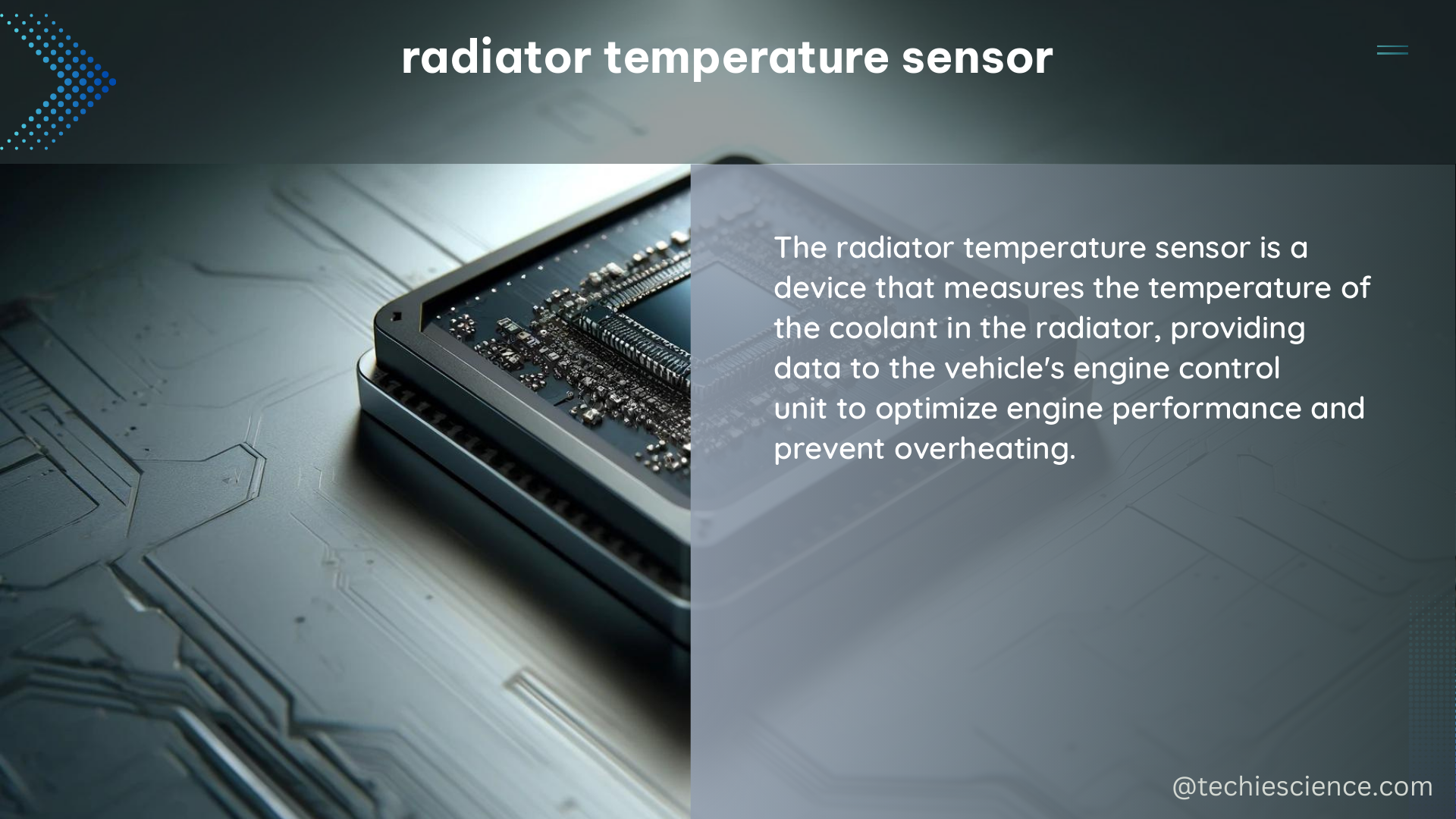The radiator temperature sensor is a critical component in a vehicle’s cooling system, responsible for monitoring the engine coolant temperature and ensuring it remains within a safe operating range. This sensor plays a vital role in maintaining engine health and preventing overheating, making it an essential part of any vehicle’s maintenance routine.
Understanding the Radiator Temperature Sensor
The radiator temperature sensor is typically a thermistor or a resistance temperature detector (RTD) that measures the temperature of the engine coolant in degrees Celsius or Fahrenheit. This data is then transmitted to the vehicle’s engine control unit (ECU), which uses it to adjust the cooling system as needed.
Temperature Range
One of the key measurable aspects of the radiator temperature sensor is its temperature range. Typically, these sensors can operate within a range of -40°C to 250°C (-40°F to 482°F). This wide range ensures accurate temperature measurement under various operating conditions, from extreme cold to scorching heat.
Accuracy
The accuracy of the radiator temperature sensor is another crucial factor. Most sensors are specified to have an accuracy of ±2°C to ±5°C (±3.6°F to ±9°F). This level of precision is essential for maintaining a safe engine operating temperature and preventing overheating.
Response Time
The sensor’s response time is also a critical consideration. Radiator temperature sensors are often specified in terms of their response time, which is typically measured in seconds or fractions of a second. A faster response time allows for more precise temperature control and quicker detection of potential cooling system issues.
Technical Specifications
As mentioned earlier, radiator temperature sensors are typically either thermistors or RTDs. Thermistors are temperature-sensitive resistors that change resistance with temperature, while RTDs use a coil of fine wire to measure temperature changes.
Thermistors generally offer higher sensitivity, making them more responsive to temperature changes. However, RTDs tend to provide greater accuracy and stability over a wider temperature range.
DIY Installation and Calibration

When it comes to DIY installation and calibration of the radiator temperature sensor, it’s essential to follow specific guidelines to ensure accurate temperature measurement.
Sensor Positioning
Proper positioning of the sensor within the cooling system is crucial. The sensor should be placed in a location that allows it to accurately measure the coolant temperature, typically near the radiator inlet or outlet.
Shielding and Insulation
Shielding the sensor from external heat sources and using insulating material to prevent unintended temperature fluctuations can also help ensure accurate readings.
Calibration
Calibrating the radiator temperature sensor is another important step in the installation process. This may involve adjusting the sensor’s resistance or voltage output to match the actual coolant temperature, ensuring the ECU receives accurate data.
Troubleshooting and Maintenance
If the radiator temperature sensor is not functioning correctly, it can lead to various issues, such as engine overheating, poor fuel efficiency, and even engine damage. Regular maintenance and troubleshooting can help identify and address any problems with the sensor.
Sensor Failure Symptoms
Some common symptoms of a failing radiator temperature sensor include:
– Erratic or fluctuating temperature readings
– Sudden spikes or drops in coolant temperature
– Check engine light illumination
– Poor engine performance or fuel economy
Troubleshooting Techniques
To troubleshoot a radiator temperature sensor, you can use a multimeter to check the sensor’s resistance or voltage output and compare it to the manufacturer’s specifications. If the sensor is not within the expected range, it may need to be replaced.
Conclusion
The radiator temperature sensor is a critical component in a vehicle’s cooling system, responsible for monitoring the engine coolant temperature and ensuring it remains within a safe operating range. By understanding the key measurable aspects of the sensor, such as its temperature range, accuracy, and response time, as well as the proper installation and calibration techniques, DIY enthusiasts can ensure their vehicle’s cooling system is functioning at its best.
References:
- ENERGY SAVINGS TOOLBOX – An Energy Audit Manual and Tool. (n.d.). Retrieved from https://natural-resources.canada.ca/sites/nrcan/files/oee/pdf/publications/infosource/pub/cipec/energyauditmanualandtool.pdf
- 40 CFR Part 51 — Requirements for Preparation, Adoption, and Submittal of Implementation Plans; National Ambient Air Quality Standards for Lead; National Emission Standards for Hazardous Air Pollutants for Source Category: Primary Lead Smelting; National Primary and Secondary Drinking Water Regulations for Lead; and Approval of State Underground Storage Tank Programs. (n.d.). Retrieved from https://www.ecfr.gov/current/title-40/chapter-I/subchapter-C/part-51
- goddard technical standard gsfc-std-7000b. (2021, April 28). Retrieved from https://standards.nasa.gov/sites/default/files/standards/GSFC/B/0/gsfc-std-7000b_signature_cycle_04_28_2021_fixed_links.pdf

The lambdageeks.com Core SME Team is a group of experienced subject matter experts from diverse scientific and technical fields including Physics, Chemistry, Technology,Electronics & Electrical Engineering, Automotive, Mechanical Engineering. Our team collaborates to create high-quality, well-researched articles on a wide range of science and technology topics for the lambdageeks.com website.
All Our Senior SME are having more than 7 Years of experience in the respective fields . They are either Working Industry Professionals or assocaited With different Universities. Refer Our Authors Page to get to know About our Core SMEs.